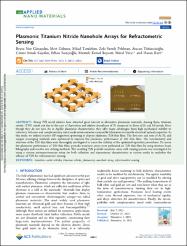| dc.contributor.author | Günaydın, Beyza Nur | |
| dc.contributor.author | Gülmez, Mert | |
| dc.contributor.author | Torabfam, Milad | |
| dc.contributor.author | Pehlivan, Zeki Semih | |
| dc.contributor.author | Tütüncüoğlu, Atacan | |
| dc.contributor.author | Kayalan, Cemre Irmak | |
| dc.contributor.author | Saatçioğlu, Erhan | |
| dc.contributor.author | Bayazıt, Mustafa Kemal | |
| dc.contributor.author | Yüce, Meral | |
| dc.contributor.author | Kurt, Hasan | |
| dc.date.accessioned | 2023-12-15T08:11:33Z | |
| dc.date.available | 2023-12-15T08:11:33Z | |
| dc.date.issued | 2023 | en_US |
| dc.identifier.citation | Günaydın, B. N., Gülmez, M., Torabfam, M., Pehlivan, Z. S., Tütüncüoğlu, A., Kayalan, C. I. ... Kurt, H. (2023). Plasmonic titanium nitride nanohole arrays for refractometric sensing. ACS Applied Nano Materials, 6(22), 20612-20622. https://dx.doi.org/10.1021/acsanm.3c03050 | en_US |
| dc.identifier.issn | 2574-0970 | |
| dc.identifier.uri | https://dx.doi.org/10.1021/acsanm.3c03050 | |
| dc.identifier.uri | https://hdl.handle.net/20.500.12511/12011 | |
| dc.description.abstract | Group IVB metal nitrides have attracted great interest as alternative plasmonic materials. Among them, titanium nitride (TiN) stands out due to the ease of deposition and relative abundance of Ti compared to those of Zr and Hf metals. Even though they do not have Au or Ag-like plasmonic characteristics, they offer many advantages, from high mechanical stability to refractory behavior and complementary metal oxide semiconductor-compatible fabrication to tunable electrical/optical properties. In this study, we utilized reactive RF magnetron sputtering to deposit plasmonic TiN thin films. The flow rate and ratio of Ar/N2 and oxygen scavenging methods were optimized to improve the plasmonic performance of TiN thin films. The stoichiometry and structure of the TiN thin films were thoroughly investigated to assess the viability of the optimized operation procedures. To assess the plasmonic performance of TiN thin films, periodic nanohole arrays were perforated on TiN thin films by using electron beam lithography and reactive ion etching methods. The resulting TiN periodic nanohole array with varying periods was investigated by using a custom microspectroscopy setup for both reflection and transmission characteristics in various media to underline the efficacy of TiN for refractometric sensing. | en_US |
| dc.description.sponsorship | 101111321 ; EP/Y030273/1 | en_US |
| dc.language.iso | eng | en_US |
| dc.publisher | American Chemical Society | en_US |
| dc.rights | info:eu-repo/semantics/openAccess | en_US |
| dc.rights | Attribution 4.0 International | * |
| dc.rights.uri | https://creativecommons.org/licenses/by/4.0/ | * |
| dc.subject | Transition Metal Nitrides | en_US |
| dc.subject | Titanium Nitride | en_US |
| dc.subject | Plasmonics | en_US |
| dc.subject | Nanohole Array | en_US |
| dc.subject | Refractometric Sensing | en_US |
| dc.title | Plasmonic titanium nitride nanohole arrays for refractometric sensing | en_US |
| dc.type | article | en_US |
| dc.relation.ispartof | ACS Applied Nano Materials | en_US |
| dc.department | İstanbul Medipol Üniversitesi, Rektörlük, Sağlık Bilim ve Teknolojileri Araştırma Enstitüsü | en_US |
| dc.department | İstanbul Medipol Üniversitesi, Mühendislik ve Doğa Bilimleri Fakültesi, Endüstri Mühendisliği Bölümü | en_US |
| dc.authorid | 0000-0002-1677-644X | en_US |
| dc.identifier.volume | 6 | en_US |
| dc.identifier.issue | 22 | en_US |
| dc.identifier.startpage | 20612 | en_US |
| dc.identifier.endpage | 20622 | en_US |
| dc.relation.tubitak | info:eu-repo/grantAgreement/TUBITAK/SOBAG/120F165 | |
| dc.relation.publicationcategory | Makale - Uluslararası Hakemli Dergi - Kurum Öğretim Elemanı | en_US |
| dc.identifier.doi | 10.1021/acsanm.3c03050 | en_US |
| dc.institutionauthor | Kurt, Hasan | |
| dc.identifier.wosquality | Q2 | en_US |
| dc.identifier.wos | 001109824500001 | en_US |
| dc.identifier.scopus | 2-s2.0-85179160088 | en_US |
| dc.identifier.pmid | 38037604 | en_US |
| dc.identifier.scopusquality | Q1 | en_US |



















